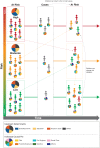Predicting Dental Caries Outcomes in Children: A "Risky" Concept
- PMID: 26647391
- PMCID: PMC4766957
- DOI: 10.1177/0022034515620779
Predicting Dental Caries Outcomes in Children: A "Risky" Concept
Abstract
In recent years, unprecedented gains in the understanding of the biology and mechanisms underlying human health and disease have been made. In the domain of oral health, although much remains to be learned, the complex interactions between different systems in play have begun to unravel: host genome, oral microbiome with its transcriptome, proteome and metabolome, and more distal influences, including relevant behaviors and environmental exposures. A reasonable expectation is that this emerging body of knowledge can help improve the oral health and optimize care for individuals and populations. These goals are articulated by the National Institutes of Health as "precision medicine" and the elimination of health disparities. Key processes in these efforts are the discovery of causal factors or mechanistic pathways and the identification of individuals or population segments that are most likely to develop (any or severe forms of) oral disease. This article critically reviews the fundamental concepts of risk assessment and outcome prediction, as they relate to early childhood caries (ECC)-a common complex disease with significant negative impacts on children, their families, and the health system. The article highlights recent work and advances in methods available to estimate caries risk and derive person-level caries propensities. It further discusses the reasons for their limited utility in predicting individual ECC outcomes and informing clinical decision making. Critical issues identified include the misconception of defining dental caries as a tooth or surface-level condition versus a person-level disease; the fallacy of applying population-level parameters to individuals, termed privatization of risk; and the inadequacy of using frequentist versus Bayesian modeling approaches to derive individual disease propensity estimates. The article concludes with the notion that accurate caries risk assessment at the population level and "precision dentistry" at the person level are both desirable and achievable but must be based on high-quality longitudinal data and rigorous methodology.
Keywords: disease susceptibility; evidence-based dentistry; oral health; pediatric dentistry; risk assessment; systems biology.
© International & American Associations for Dental Research 2015.
Conflict of interest statement
The author declares no potential conflicts of interest with respect to the authorship and/or publication of this article.
Figures


References
-
- American Academy of Pediatric Dentistry (AAPD). 2013. Guideline on caries-risk assessment and management for infants, children, and adolescents. Reference manual. Chicago (IL): AAPD; [accessed 2015 October 17]. http://www.aapd.org/media/Policies_Guidelines/G_CariesRiskAssessment.pdf. - PubMed
-
- American Academy of Pediatrics (AAP). 2015. Oral health risk assessment tool [accessed 2015 October 17]. http://www2.aap.org/oralhealth/docs/riskassessmenttool.pdf.
-
- American Dental Association (ADA). 2015. Caries risk assessment [accessed 2015 October 17]. http://www.ada.org/~/media/ADA/Science%20and%20Research/Files/topic_cari....
-
- Belda-Ferre P, Williamson J, Simon-Soro Á, Artacho A, Jensen ON, Mira A. 2015. The human oral metaproteome reveals potential biomarkers for caries disease. Proteomics. 15(20):3497–3507. - PubMed
Publication types
MeSH terms
Grants and funding
LinkOut - more resources
Full Text Sources
Other Literature Sources
Medical
Molecular Biology Databases

